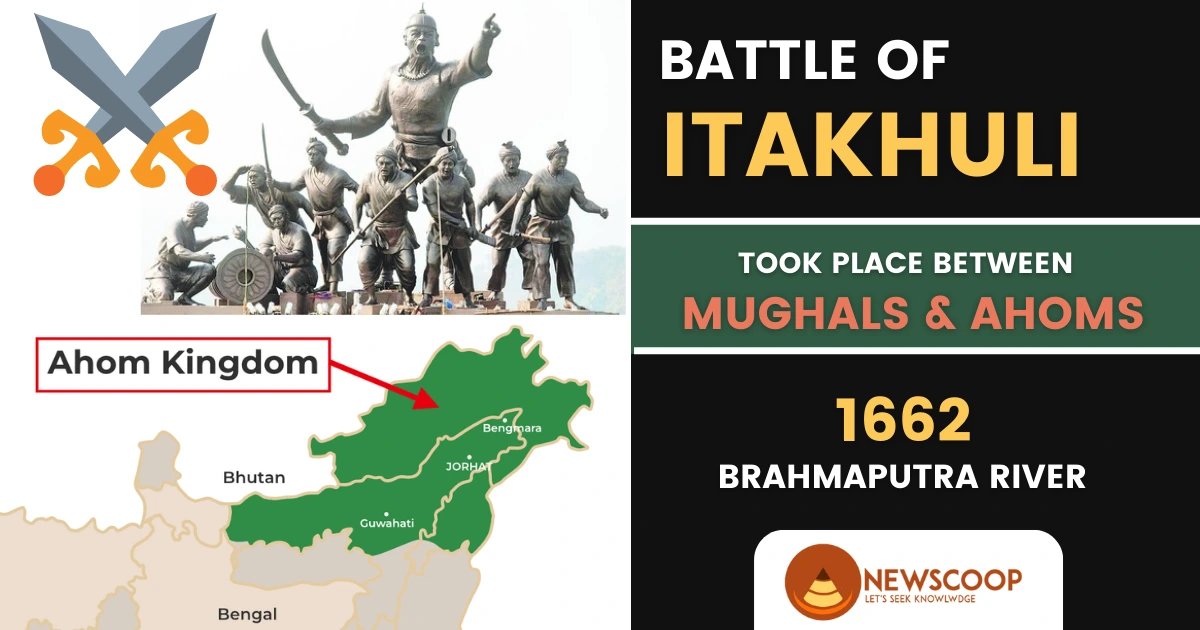The Battle of Itakhuli is a pivotal moment in the history of the Indian subcontinent, showcasing the clash between two formidable powers: the Mughal Empire and the Ahom Kingdom. Fought in the early 17th century, this battle holds great significance, not only in terms of military strategy and tactics but also in shaping the regional balance of power.
In this comprehensive article, we will explore the historical context, key players, military strategies, unfolding events, and lasting implications of the Battle of Itakhuli.
History of the Battle of Itakhuli
The Ahom Kingdom, located in present-day Assam, had long maintained its sovereignty against numerous invasions throughout the centuries. However, in the early 17th century, the Mughal Empire, under the rule of Emperor Jahangir, sought to expand its influence into the northeastern regions of the subcontinent. The Mughals aimed to bring the Ahom Kingdom under their suzerainty, tapping into its resources and trade routes.
Ahom Kingdom & Mughal Empire
- Mughal Empire: Led by Mir Jumla, an experienced Mughal commander and governor of Bengal, the Mughal forces comprised a well-trained army equipped with advanced weaponry. The Mughals aimed to exert control over the Ahom Kingdom and its rich territories.
- Ahom Kingdom: Ruled by King Pratap Singha, the Ahom Kingdom boasted a reputation for its military prowess and skilled warriors. Determined to repel the Mughal invasion and preserve their land and independence, the Ahom forces rallied under their capable leadership.
Battle of Itakhuli
The Battle of Itakhuli took place in 1662 near the Itakhuli hill, situated on the banks of the Brahmaputra River in present-day Guwahati, Assam. The Ahom forces carefully chose the battlefield, capitalizing on the hilly terrain that provided natural barriers against the Mughal cavalry and artillery.
Despite being outnumbered, the Ahom warriors employed guerrilla warfare tactics to maximize their advantages. They relied on their intimate knowledge of the local terrain to launch surprise attacks, ambushing the Mughal forces from dense forests and inflicting heavy casualties. The Ahom warriors effectively utilized their expertise in river warfare, employing small boats and canoes to harass the Mughal troops attempting to cross the Brahmaputra River.
Mir Jumla, faced with mounting losses and recognizing the Ahom Kingdom’s tenacity, opted for negotiations instead of further bloodshed. The Ahom Kingdom, sensing an opportunity for a favorable settlement, agreed to a peace treaty with the Mughals, marking the end of the Battle of Itakhuli.

What were the implications of the Battle of Itakhuli?
The Battle of Itakhuli had significant implications for both the Mughal Empire and the Ahom Kingdom:
- Ahom Kingdom’s Independence: The Ahom Kingdom’s successful defense against the Mughal invasion in the Battle of Itakhuli ensured the preservation of its independence. It remained one of the few regions in the Indian subcontinent that remained unconquered by the Mughals.
- Mughal Expansion Hindered: The Mughal Empire’s ambitions to extend its influence over the northeastern territories were curtailed by the Ahom Kingdom’s resistance. The battle marked a setback in their expansionist policies.
- Ahom-Mughal Relations: The peace treaty that followed the battle allowed for the establishment of diplomatic relations between the Ahom Kingdom and the Mughal Empire. While the Ahom Kingdom maintained its autonomy, the treaty resulted in a tribute-based relationship between the two powers.
Conclusion
The Battle of Itakhuli remains a testament to the resilience and military prowess of the Ahom Kingdom against the Mughal Empire. It stands as a pivotal moment in history when the northeastern region of the Indian subcontinent expanded the boundaries of their independence. The Ahom Kingdom’s successful defense at Itakhuli played a crucial role in shaping the geopolitical landscape of the region.
Furthermore, the Battle of Itakhuli highlighted the effectiveness of guerrilla warfare and the importance of strategic terrain in military engagements. The Ahom warriors‘ knowledge of the local environment, combined with their skillful use of ambush tactics and river warfare, proved instrumental in their victory.
The battle also demonstrated the Mughal Empire’s limits in expanding its dominion. Despite their superior numbers and advanced weaponry, the Mughals encountered significant resistance from the Ahom forces. The outcome of the battle served as a reminder that not all regions could be easily subdued by the Mughals, reinforcing the decentralized nature of power in the Indian subcontinent during that era.
In conclusion, the Battle of Itakhuli remains a crucial event in the history of the Indian subcontinent. It symbolizes the resilience and determination of the Ahom Kingdom to protect its independence against the powerful Mughal Empire. The Ahom victory at Itakhuli not only secured their territorial integrity but also influenced subsequent dynamics between the Mughals and other regional powers.
The battle stands as a testament to the strategic acumen and military capabilities of the Ahom warriors, whose valiant efforts left an indelible mark on the historical narrative of the Indian subcontinent.
Thank You!





